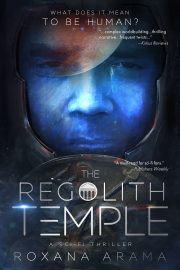Guest Post: What’s Wrong with the Cheesecake? — A Brief Introduction to Antagonists
by Nancy Fulda
 Writers love to talk about motivations. We jabber cheerfully about character arcs and driving needs and how much more interesting a book becomes when the protagonist is active rather than passive. We speak — very frequently, and with great enthusiasm — about giving characters dreams; goals; a desperately-desired objective.
Writers love to talk about motivations. We jabber cheerfully about character arcs and driving needs and how much more interesting a book becomes when the protagonist is active rather than passive. We speak — very frequently, and with great enthusiasm — about giving characters dreams; goals; a desperately-desired objective.
Since that topic’s pretty much been covered, I’m not going to discuss the importance of goals today. Instead, I’m going to discuss how worthless they are.
You heard me. The carefully-constructed goals you have concocted for your character are, sadly, meaningless… UNLESS they are paired with a compelling antagonist.
Still with me? I’ll explain it mathematically.
goal + obstacle => empathy
In words: The combination of a goal and an obstacle generates empathy.
Remove either the goal or the obstacle, and the reader has no reason to get emotionally invested. That may sound obvious to some of you, but the lack of a credible antagonist is a very common flaw in fiction.
Let’s suppose your main character likes cheesecake. No wait. She doesn’t just like it; she adores it with a palpable passion. This woman would die for cheesecake. She would kill for it. She would climb the empire state building barehanded for… well, you get the idea.
Are you feeling any emotional connection to this woman? I’m not. No matter how many ways you try to spin it, Jane desperately craves cheesecake is not a story.
Why not? Because there’s cheesecake in every restaurant and corner store this side of the Atlantic, that’s why. The more time we spend establishing Jane’s urgent need for cheesecake, the more the reader’s going to think: “Enough about the cheesecake, already! If you care that freaking much, then why don’t you go eat some?”
Let’s pair Jane’s cheesecake craving with some possible antagonists.
Jane desperately craves a piece of strawberry cheesecake, but she is deathly allergic to strawberries.
Jane desperately craves a piece of strawberry cheesecake, but she doesn’t want to look like a glutton in front of her friends.
Jane desperately craves a piece of strawberry cheesecake, but cheesecake has been outlawed by the recently-appointed dictator of the United States.
Interesting, isn’t it, how each antagonist sends the story cavorting in an entirely different direction?
If you’re like me, at least one of the above sentences got an emotional response. Not a huge response, of course, because we’ve only got the seed of a story. We’d have to layer in a lot more detail to properly tug a reader’s heartstrings. But at least the story now has conflict.
Here’s another little equation for you:
conflict = tension = goal + obstacle
When your critique group starts complaining that your work doesn’t have enough tension: check for antagonists. Most authors instinctively establish goals as a story progresses, but they often forget to highlight the reasons why those goals are currently unattainable.
Stories arise from the intersection of a desire and an obstacle. Remember this the next time you start drafting. And always — always — give your protagonist a compelling reason not to eat the cheesecake.
***
Nancy Fulda is a Phobos Award Winner, a Vera Hinckley Mayhew Award recipient, and the winner of the 2011 Jim Baen Memorial Award. She studied artificial intelligence during her graduate work at Brigham Young University. During the years since, she has grappled with the far more complex process of raising three small children.
Nancy has been a featured writer at Apex Online, a guest at the Writing Excuses podcast, and is a regular attendee of the Villa Diodati Writers’ Workshop. Her short story, “Movement,” is eligible for this year’s Hugo and Nebula Awards.


